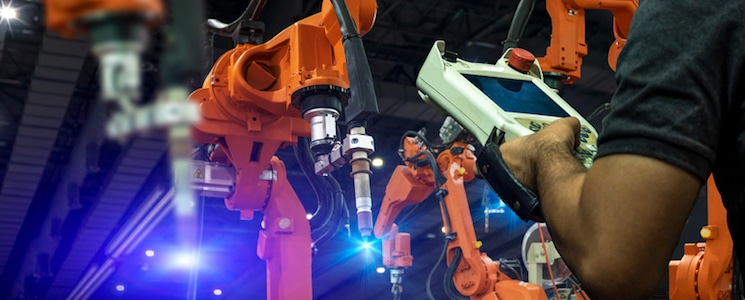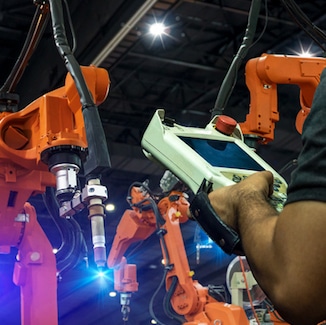
I recently wrote about the competitive threat faced by the Aerospace & Defense and other complex discrete manufacturers that neglect to execute upon a digital transformation strategy. As new digital marketplaces continue to evolve and expand, there is a risk of being left behind if investments are not made now to be part of this ecosystem – either by building it yourself or partnering with others. Fortunately, an industry ecosystem can be readily established that is valuable to customers and end users – some already exist. The first step is to establish digital continuity both internally and externally across your organization as part of a digital transformation strategy that spans your operations.
Related article: What Manufacturers Can Learn from the Digital Transformation of Other Industries
Related article: Create a Manufacturing Ecosystem by Taking a Cue from the Tech Giants
A recent McKinsey Periscope Machinery and Industrial Automation survey makes it clear that digitization has the power to change the game for the manufacturing industry. Twenty-five percent of respondents have already digitized services, spare parts and consumables (source). Most of the rest plan to do so imminently. McKinsey’s conclusion is that commitment to digital processes is the best path to continuing success. Companies that are more digitally mature with greater digital continuity will see the return in terms of greater revenue growth and shareholder value.
In Search of Further Digital Maturity
The challenge that manufacturers and machinery providers face today is that less than ten percent can be classed as highly “digitally” mature. Those that have made the shift to digitalizing their organizations have been rewarded with triple the return to shareholders and quadruple a Compounded Annual Growth Rate (CAGR) over a five-year period. These figures were calculated by McKinsey and published in this article, Radically rethink your strategy: How digital B2B ecosystems can help traditional manufacturers create and protect value.
McKinsey noted that digital impacts the entire value chain. OEMs and major suppliers are harnessing digital applications to enhance efficiency. Supply chain partners can link together their systems to ensure delays are kept to a minimum, inventory levels are adequate, and deadlines are met.
Digitization has also opened the door to the implementation of artificial intelligence (AI) as a means of understanding patterns that lie hidden within vast mountains of data. AI can detect trends that would otherwise go unnoticed. Not only that, it can often provide insight in real-time as an aid to strategy, overall management, and in bringing products to market far faster than before.
The presence of autonomous robots is also raising manufacturing performance. By establishing digital continuity by connecting these robots to ERP, MES, and PLM systems, shop floor efficiency is boosted and the assembly-line pace is increased. Similarly, distribution networks are materially aided by the establishment of a digital thread that ties together every component and system to its related BOM, supplier, shipping label, assembly-line action, and point of delivery.
Getting Started with Digital Continuity
Without a doubt, digitization is coming. Yet far too many companies find themselves quite low on the digital maturity curve. Those that don’t act soon risk falling far behind their competitors.
Today, this threat is larger than ever. The big tech giants have shown what is possible. A digital marketplace can be scaled quite large to efficiently serve many buyers with far greater effectiveness for a lower price. Manufacturers can learn from this model and choose to either participate or create their own comparable ecosystem.
Given the trend to offer anything “as-a-service,” it shouldn’t be a surprise that we are starting to see more “Manufacturing-as-a-Service” and “Parts-as-a-Service” offerings. Given the speed, efficiency, and reach of a digital platform, it will soon be nearly impossible to compete without operations that have been completely transformed as part of a digital ecosystem.
A new offering by iBase-t has introduced a quick way to get started. Its Fast Value program has been pre-configured to streamline implementation as a packed offering that includes software licenses, implementation services, training, and maintenance support for the entire first year at a price that is a fraction of what this type of solution would traditionally cost. Operating initially as stand-alone, this type of fast-start program is an ideal way to get started, understand ROI potential, and then to plan the rest of your digital transformation.
Frenemies the New Norm?
The next step is implementing a digital ecosystem is to either collaborate with other platform service providers, work with the competitors, or build your own platform. It often takes a disruptive event for change to occur at the level that we will likely see over the next few years. This might be the market that A&D providers face soon. Partnering with others that can help defray your capital investment while adding value from a diversified and comprehensive offering. Much will be learned during this process. One thing is for certain – we do indeed live in interesting times where change seems to be the only constant.
It is highly likely that some form of an ecosystem will emerge. We may soon see a day when each of the larger Aerospace & Defense companies join to build an ecosystem. This ecosystem will need to be intuitive, easy to use, and sought after by customers. If such an environment can be created, it will only occur by learning from others, taking on a new perspective, and investing heavily in creating digital continuity across both your own and other systems, process and operations infrastructures.

